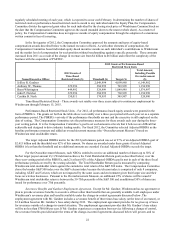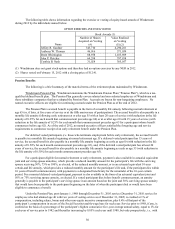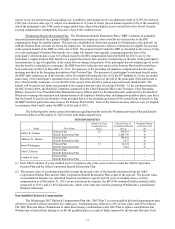Windstream 2012 Annual Report Download - page 27
Download and view the complete annual report
Please find page 27 of the 2012 Windstream annual report below. You can navigate through the pages in the report by either clicking on the pages listed below, or by using the keyword search tool below to find specific information within the annual report.
metric for this purpose in lieu of total revenue because service revenue was over 90% of Windstream’s total revenue during
2012 and due to the uncertainty surrounding the FCC’s inter-carrier compensation reform, adopted in December 2011, it was
very difficult to accurately estimate target amounts for wholesale, switched access and USF revenue for the 2012 fiscal year.
Under the Windstream short-term incentive plan, executive officers were eligible to receive payments in proportion
to Windstream’s achievement of a performance goal that was set at minimum (or threshold), target and maximum levels. For
2012, payouts were based 70% on the achievement of the Adjusted OIBDA goal and 30% based on the achievement of the
Adjusted Revenue goal. The Compensation Committee set each performance goal at levels that it believes to be difficult but
achievable and designed to drive industry leading results. The executive officers were eligible to receive 50% to 200% of the
target payout amounts if threshold or maximum levels, respectively, were achieved. No payout is made if performance is
below the threshold levels, and performance between threshold, target and maximum levels results in prorated payouts.
During 2012, the threshold Adjusted OIBDA amount was $2.367 billion, the target was $2.415 billion and the maximum was
$2.464 billion, and the threshold Adjusted Revenue amount was $4.747 billion, the target was $4.894 billion and the
maximum was $4.943 billion. Windstream’s actual Adjusted OIBDA for 2012 was $2.388 billion, which reflected an
approximate 72% payout. Its actual Adjusted Revenue for 2012 was $4.951 billion, which reflected an approximate 200%
achievement level against the target performance goal. The overall achievement level calculated based on the 2012 financial
results was 110%. However, based on a number of factors, including company stock performance and negative
developments regarding PAETEC revenue during 2012, the Committee exercised its negative discretion to reduce the payout
to 90%. The following table shows the target payouts and actual payouts (in each case, expressed as a percentage of base
salary) for each NEO under the short-term incentive plan for 2012:
Named Executive Officer Target Payout Percentage Actual Payout Percentage
Jeffery R. Gardner 135% 122%
Anthony W. Thomas 80% 72%
Brent Whittington 80% 72%
John P. Fletcher 80% 72%
Cynthia B. Nash 70% 63%
The Compensation Committee set the target payout percentages for the NEOs at the beginning of the fiscal year
based on such individual’s contributions to Windstream and the market level of compensation for such position without
benchmarking against a specific percentile. The Compensation Committee set Mr. Gardner’s target payout percentage level
above the other NEOs given his leadership role within Windstream and his ability to affect stockholder value relative to other
NEOs.
Long Term Equity-Based Incentive Awards. Windstream maintains an equity-based compensation program for
executive officers to provide long-term incentives, to better align the interests of executives with stockholders and to provide
a retention incentive. The Compensation Committee implemented its equity-based compensation program as part of its goal
to make a substantial portion of total direct compensation at risk.
Each year NEOs receive a portion of his or her total direct annual compensation in the form of long-term equity-
based incentive compensation. All Windstream equity compensation awards are issued as either time-based restricted stock
or performance-based restricted stock units (PBRSUs) under the Windstream Amended and Restated 2006 Equity Incentive
Plan (“Equity Plan”). In 2012, 70% of the equity compensation granted to the named executive officers (other than Mr.
Gardner) was performance-based and 30% was time-based vesting. For Mr. Gardner, 100% of his 2012 equity compensation
was performance-based. Windstream has not issued any stock options or other forms of equity compensation to its directors,
executive officers or other employees. The Compensation Committee believes that restricted stock or performance-based
restricted stock or unit awards are a preferred mechanism of equity compensation compared to stock options or other devices
that derive value from future stock price appreciation due to the high-dividend, low-growth profile of Windstream. In
addition, performance-based restricted stock units are eligible for deduction for tax purposes under Section 162(m) of the
Internal Revenue Code.
For all outstanding grants of time-based restricted stock, executive officers have the rights of a stockholder to vote
the restricted stock and to receive any cash dividends paid with respect to the restricted shares during the vesting period. For
all outstanding grants of performance-based equity compensation, the dividends are accrued and paid out only when and if
the performance conditions are satisfied.
The Windstream Board of Directors delegated responsibility for administration of the Equity Plan, including the
authority to approve awards, to the Compensation Committee. It is the Compensation Committee's policy to review and
approve all annual equity compensation awards to directors, executive officers and all other eligible employees at its first
21
























